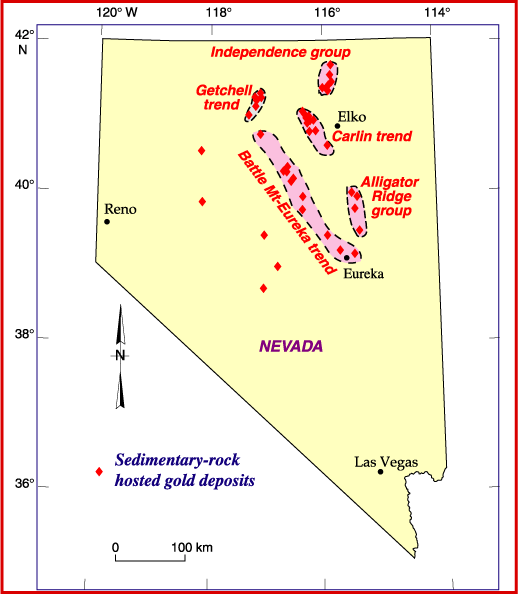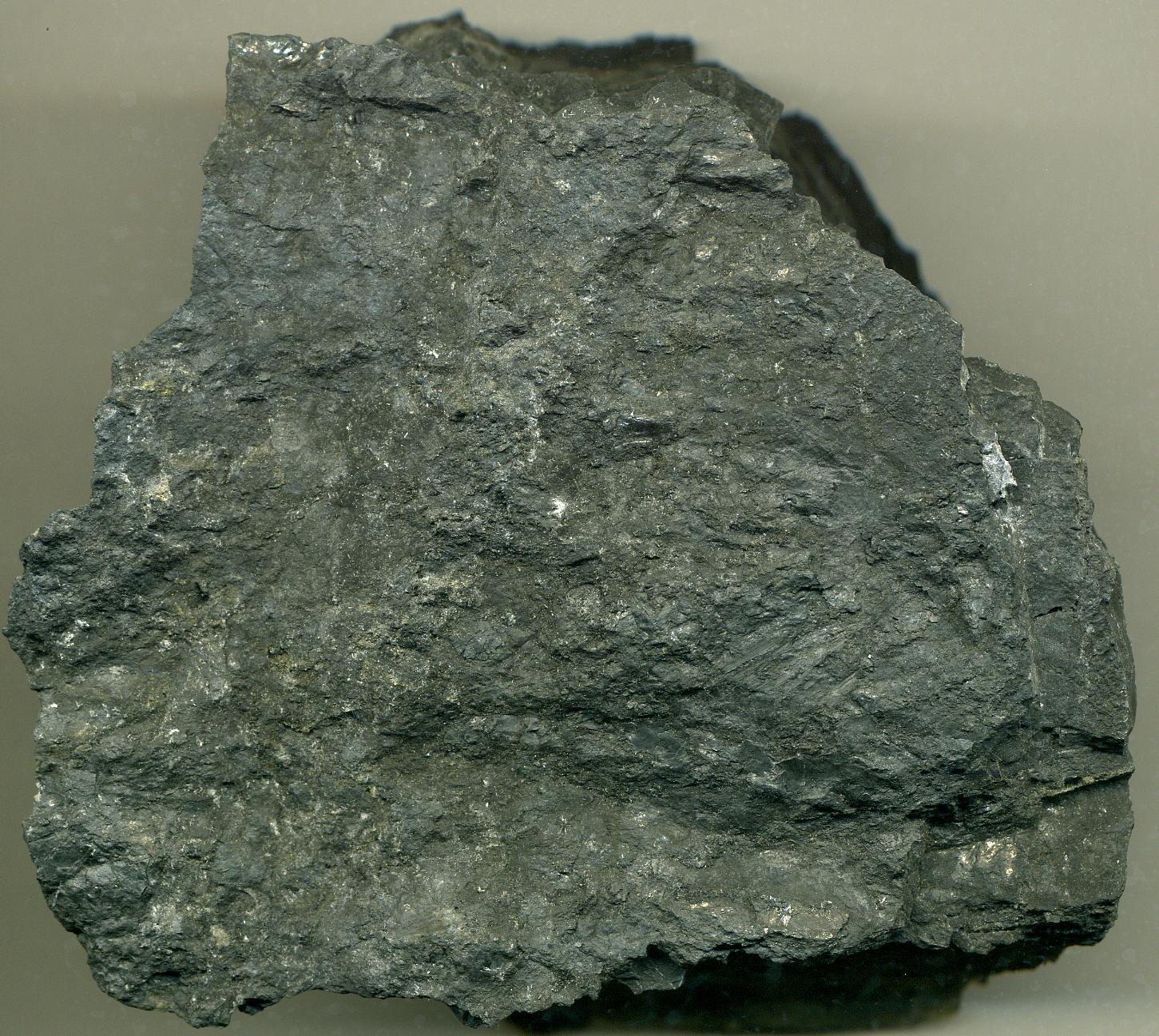Carlin–type gold deposit on:
[Wikipedia]
[Google]
[Amazon]

 Carlin–type gold deposits are
Carlin–type gold deposits are
"The Rush to Uncover Gold’s Origins"
Geotimes, April 2006 {{DEFAULTSORT:Carlin-type gold deposit Economic geology Ore deposits Gold mining

 Carlin–type gold deposits are
Carlin–type gold deposits are sediment
Sediment is a solid material that is transported to a new location where it is deposited. It occurs naturally and, through the processes of weathering and erosion, is broken down and subsequently sediment transport, transported by the action of ...
-hosted disseminated gold
Gold is a chemical element; it has chemical symbol Au (from Latin ) and atomic number 79. In its pure form, it is a brightness, bright, slightly orange-yellow, dense, soft, malleable, and ductile metal. Chemically, gold is a transition metal ...
deposits. These deposits are characterized by invisible (typically microscopic and/or dissolved) gold in arsenic rich pyrite and arsenopyrite
Arsenopyrite ( IMA symbol: Apy) is an iron arsenic sulfide (FeAsS). It is a hard ( Mohs 5.5–6) metallic, opaque, steel grey to silver white mineral with a relatively high specific gravity of 6.1.
When dissolved in nitric acid, it releases el ...
. This dissolved kind of gold is called "invisible gold", as it can only be found through chemical analysis. The deposit is named after the Carlin mine, the first large deposit of this type discovered in the Carlin Trend, Nevada
Nevada ( ; ) is a landlocked state in the Western United States. It borders Oregon to the northwest, Idaho to the northeast, California to the west, Arizona to the southeast, and Utah to the east. Nevada is the seventh-most extensive, th ...
.
Geology
The Carlin type deposits show enrichment in the elementsgold
Gold is a chemical element; it has chemical symbol Au (from Latin ) and atomic number 79. In its pure form, it is a brightness, bright, slightly orange-yellow, dense, soft, malleable, and ductile metal. Chemically, gold is a transition metal ...
, arsenic
Arsenic is a chemical element; it has Symbol (chemistry), symbol As and atomic number 33. It is a metalloid and one of the pnictogens, and therefore shares many properties with its group 15 neighbors phosphorus and antimony. Arsenic is not ...
, antimony
Antimony is a chemical element; it has chemical symbol, symbol Sb () and atomic number 51. A lustrous grey metal or metalloid, it is found in nature mainly as the sulfide mineral stibnite (). Antimony compounds have been known since ancient t ...
, mercury, thallium
Thallium is a chemical element; it has Symbol (chemistry), symbol Tl and atomic number 81. It is a silvery-white post-transition metal that is not found free in nature. When isolated, thallium resembles tin, but discolors when exposed to air. Che ...
and barium
Barium is a chemical element; it has symbol Ba and atomic number 56. It is the fifth element in group 2 and is a soft, silvery alkaline earth metal. Because of its high chemical reactivity, barium is never found in nature as a free element.
Th ...
. This enrichment is created by hydrothermal
Hydrothermal circulation in its most general sense is the circulation of hot water (Ancient Greek ὕδωρ, ''water'',Liddell, H.G. & Scott, R. (1940). ''A Greek-English Lexicon. revised and augmented throughout by Sir Henry Stuart Jones. with th ...
circulation with a temperature of up to 300 °C. The underlying rocks out of which the minerals are dissolved are normally silt
Silt is granular material of a size between sand and clay and composed mostly of broken grains of quartz. Silt may occur as a soil (often mixed with sand or clay) or as sediment mixed in suspension (chemistry), suspension with water. Silt usually ...
y carbonates, although silicates
A silicate is any member of a family of polyatomic anions consisting of silicon and oxygen, usually with the general formula , where . The family includes orthosilicate (), metasilicate (), and pyrosilicate (, ). The name is also used for an ...
and other sediments are possible. The source of the heating for the water in the hydrothermal circulation is still under discussion. The material in the deposit is altered in a way that the carbonate mineral
Carbonate minerals are those minerals containing the carbonate ion, .
Carbonate divisions Anhydrous carbonates
*Calcite group: trigonal
**Calcite CaCO3
**Gaspéite (Ni,Mg,Fe2+)CO3
**Magnesite MgCO3
**Otavite CdCO3
**Rhodochrosite MnCO3
**Sider ...
s are either dissolved or converted to the silicates by silicate rich hydrothermal water. For example, dolomite is transformed into jasperoid. Another alteration is the formation of clay mineral
Clay minerals are hydrous aluminium phyllosilicates (e.g. kaolin, Al2 Si2 O5( OH)4), sometimes with variable amounts of iron, magnesium, alkali metals, alkaline earths, and other cations found on or near some planetary surfaces.
Clay minera ...
s by interaction of water and feldspar
Feldspar ( ; sometimes spelled felspar) is a group of rock-forming aluminium tectosilicate minerals, also containing other cations such as sodium, calcium, potassium, or barium. The most common members of the feldspar group are the ''plagiocl ...
. The absence of base metal sulfides and the even distribution of the pyrite and arsenopyrite in the host rock are the most obvious difference to other sulfide deposits.
During the Eocene, fluids flowed through the lower plate of thrust faults and the underlying fractured carbonates. These fluids were magmatic, meteoric, and metamorphic in origin. A low Ph in the fluids allowed for a significant amount of carbonate rocks to dissolve. The presence of carbonate in the water kept the fluids reduced. This reduction facilitated the movement of gold within sulfate rich epithermal fluids. The low temperature, low salinity fluids replaced the carbonate rocks with ore deposits that included gold. Later, when the Basin and Range began its extension, normal faulting took place, and the ore deposits were downfaulted and buried under alluvial sediment.
Mining
The Carlin–type deposits represent some of the largest hydrothermal gold deposits in the world. The invisible nature of the gold in the deposit makes it difficult to find deposits of that kind. The class of deposit was defined after the Carlin mine became a mass producer of gold in the 1960s and it was recognized that other deposits of that type should exist. Most of the mines in theGreat Basin
The Great Basin () is the largest area of contiguous endorheic watersheds, those with no outlets to the ocean, in North America. It spans nearly all of Nevada, much of Utah, and portions of California, Idaho, Oregon, Wyoming, and Baja Californi ...
in the United States belong to the Carlin type. Similar "Invisible Gold" deposits have also been found in northern Canada, China, Iran, and Macedonia; but the relationship between these deposits and those in Nevada are debated.
See also
* Gold mining in NevadaReferences
External links
"The Rush to Uncover Gold’s Origins"
Geotimes, April 2006 {{DEFAULTSORT:Carlin-type gold deposit Economic geology Ore deposits Gold mining